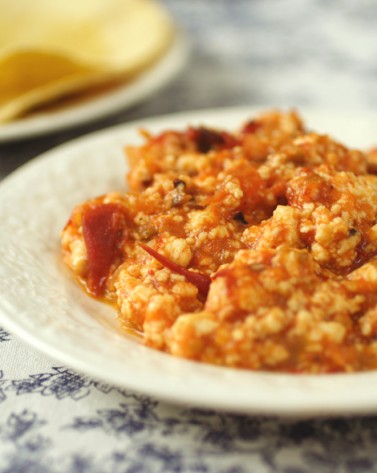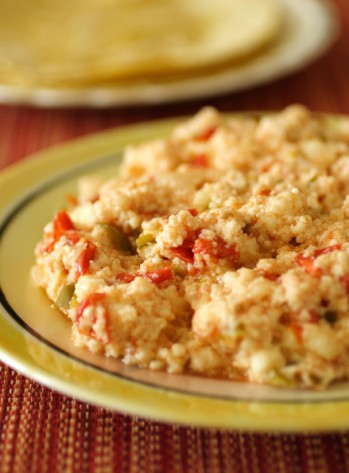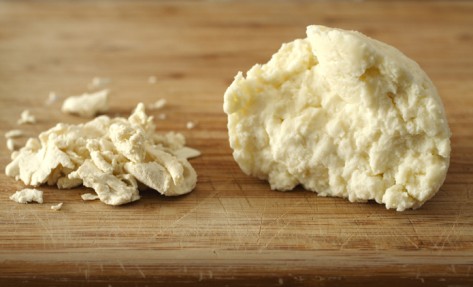Ricotta—A Cry for Help
Ricotta cheese is used in Mexican cooking in various ways—to fill squash blossoms, empanadas, tacos, quesadillas, fried pockets made with corn tortilla dough, and to make faux “scrambled egg” dishes, like the two recipes, shown below, I made from The Art of Mexican Cooking by Diana Kennedy: Ricotta Scrambled in Tomato Sauce and Ricotta Scrambled Like Mexican Eggs. Like Crumbled Indian Cheese with Peas from Entice with Spice, the first DCCC pick, these pan-fried soft cheese dishes, with their warming chile heat and pillowy soft texture, are soul-satisfying comfort foods.

Ricotta Scrambled in Tomato Sauce

Ricotta Scrambled Like Mexican Eggs
Unlike queso fresco, ricotta is easy to find in supermarkets across America, and very fresh, high-quality “hand dipped” ricotta is increasingly available in specialty stores, food co-ops, and farmers’ markets. (In Vermont, Maplebrook Farm produces a very nice whole-milk ricotta.)
So why bother to make it?
Because traditionally ricotta is made from whey, something I often have on hand after draining plain yogurt (to create a thick, Greek-style yogurt) and after the occasional fresh cheese–making experiment. I like the idea of transforming something that would otherwise be used as food for the neighbor’s pigs into something delicious and nutritious.
A week or two ago I had about two quarts of whey, so I decided to go for it, using the very easy-sounding recipe in The Art of Mexican Cooking.
I followed the instructions to the letter, but was thwarted. My yield was a mere tablespoon or so and the ricotta, I think, was not ricotta at all, though it had a pleasant, slightly sharp flavor. The texture was compact—more like cream cheese, but drier—and the color, a light beige.
After looking a bit further, I’ve come to the conclusion that making homemade ricotta from whey may not practical for thebeginning home cheesemaker.
All three sources that I referenced—the books Home Cheesemaking by Ricki Carroll and Goats Produce Too!by Mary Jane Toth and a very helpful online story and recipewritten by Jim Wallace, the cheese tech–in–residence at New England Cheesemaking Supply Company—stressed the importance of using very fresh whey. Jim Wallace stated that the whey should go directly from the cheese pot at the time of draining to making ricotta. Because the yield for ricotta made with whey is low, the amount of whey needed is a lot: Ricki Carroll’s recipe calls for two gallons to yield one to two cups of ricotta. Obviously only a large amount of cheesemaking would yield two gallons of whey at one go.
Besides the freshness factor and required whey quantity, there may be another reason to explain my paltry results. In her book, Mary Jane Toth writes that the whey used to make ricotta should not be from making soft or soft molded cheeses, which encompasses all of the cheeses that most beginning home cheesemakers are likely to make—those simple fresh cheeses such as paneer, mozzarella, chevre, queso fresco, queso blanco, and feta.
Giving up on making ricotta from whey, I tried Ricki Carroll’s recipe for whole-milk ricotta. It worked, though my yield was bit lower than that stated in her recipe. I did, however, let the cheese hang a little longer than instructed, which would affect yield, to create a drier cheese, as this is what’s called for in Diana Kennedy’s scrambled ricotta recipes. The result was delicious and much fresher tasting than the typical supermarket ricotta.

My paltry yield of homemade ricotta using whey (left) and some of the homemade ricotta using whole milk
So I guess I’ll have to continue to give the whey to the pigs—unless there is some hidden trick I don’t know. Anyone?

Try making fresh ricotta with the milk and lemon juice method.
1Thanks for the tip Peter. Ricki Carroll’s recipe calls for citric acid. Lemon juice would be easier for most folks to find. What ratio of lemon juice to milk do you use?
2Looks like whole milk might have won!!
3I see that this post is about a year old, but I thought I’d chime in. I use whey (left over from making yogurt) as a replacement for water when I make bread. Today I used it in blueberry muffins, and it’s also great in pancakes.
4Thanks for sharing your whey ideas, Vicky. I’m glad you found my old ricotta posting. I would have never thought of using whey in baking. How do you use it when making pancakes? As a substitute for buttermilk? I’d like to try it.
5